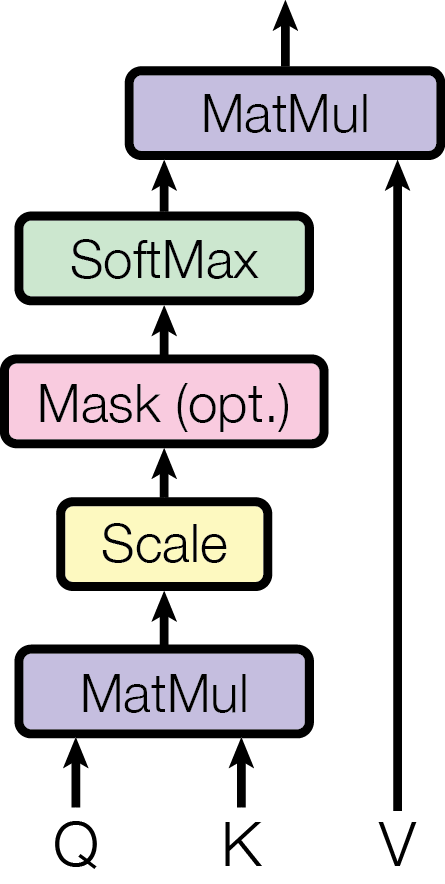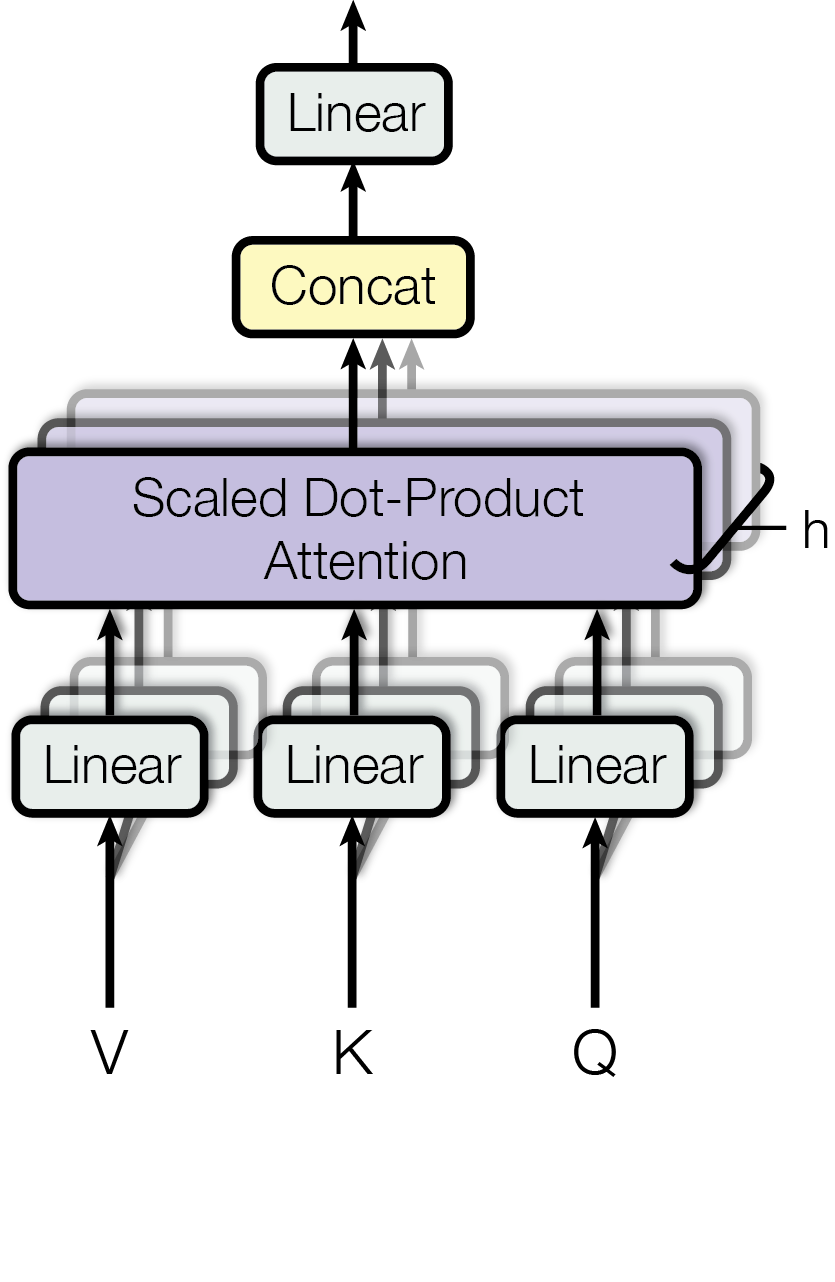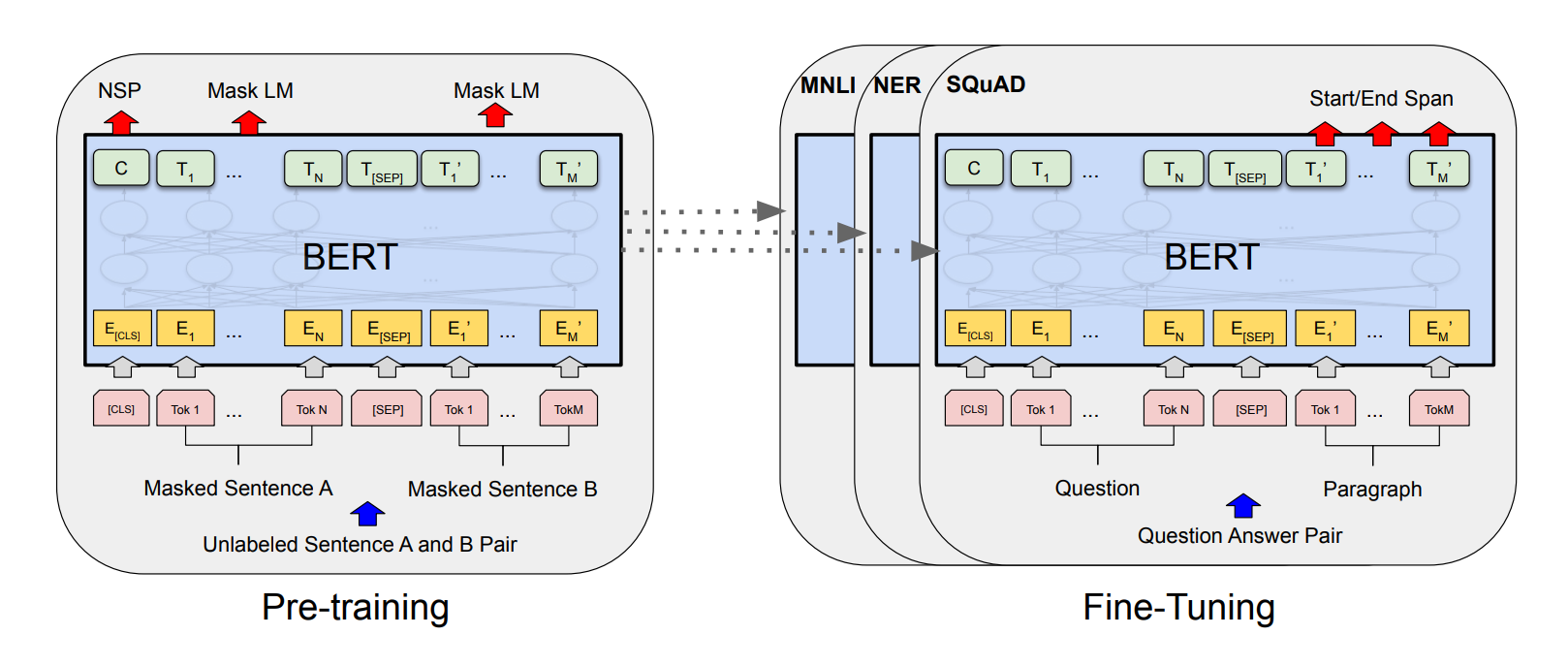1
2
3
4
5
6
7
8
9
10
11
12
13
14
15
16
17
18
19
20
21
22
23
24
25
26
27
28
29
30
31
32
33
34
35
36
37
38
39
40
41
42
43
44
45
46
47
48
49
50
51
52
53
54
55
56
57
58
59
60
61
62
63
64
65
66
67
68
69
70
71
72
73
74
75
76
77
78
79
80
81
82
83
84
85
86
87
88
89
90
91
92
93
94
95
96
97
98
99
100
101
102
103
104
105
106
107
108
109
110
111
112
113
114
115
116
117
118
119
120
121
122
123
124
125
126
127
128
129
130
131
132
133
134
135
136
137
138
139
140
141
142
143
144
145
146
147
148
149
150
151
152
153
|
import numpy as np
import math
import copy
import random
import torch
import torch.nn as nn
import torch.optim as optim
import torch.nn.functional as F
from torch.utils.data import Dataset, DataLoader
from torch.nn.init import xavier_normal_, xavier_uniform_
from multi_head_scaled_dot_product_attention import multi_head_scaled_dot_product_attention
class PositionEmbedding(nn.Module):
def __init__(self, max_len, d_model):
super(PositionEmbedding, self).__init__()
self.max_len = max_len
self.d_model = d_model
self.pe = torch.zeros(self.max_len, self.d_model, dtype = torch.float32)
pos = torch.arange(0, self.max_len, dtype=torch.float).unsqueeze(1)
div_term = torch.exp(torch.arange(0, self.d_model, 2).float() * (-math.log(10000.0)/self.d_model))
self.pe[:, 0::2] = torch.sin(pos * div_term)
self.pe[:, 1::2] = torch.cos(pos * div_term)
def forward(self, x):
b, l, d = x.shape
assert d == self.d_model
assert l <= self.max_len
return x + self.pe[:l, :].to(x.device).expand_as(x).clone().detach()
class MultiheadAttention(nn.Module):
def __init__(self, n_heads, d_model):
super(MultiheadAttention, self).__init__()
self.n_heads = n_heads
self.d_model = d_model
self.q_weight = nn.Parameter(torch.empty((d_model, d_model), dtype=torch.float32), requires_grad=True)
self.k_weight = nn.Parameter(torch.empty((d_model, d_model), dtype=torch.float32), requires_grad=True)
self.v_weight = nn.Parameter(torch.empty((d_model, d_model), dtype=torch.float32), requires_grad=True)
self.out_weight = nn.Parameter(torch.empty((d_model, d_model), dtype=torch.float32), requires_grad=True)
self.q_bias = nn.Parameter(torch.empty((1, 1, d_model), dtype=torch.float32), requires_grad=True)
self.k_bias = nn.Parameter(torch.empty((1, 1, d_model), dtype=torch.float32), requires_grad=True)
self.v_bias = nn.Parameter(torch.empty((1, 1, d_model), dtype=torch.float32), requires_grad=True)
self.out_bias = nn.Parameter(torch.empty((1, 1, d_model), dtype=torch.float32), requires_grad=True)
self._reset_parameters()
def _reset_parameters(self):
xavier_uniform_(self.q_weight)
xavier_uniform_(self.k_weight)
xavier_uniform_(self.v_weight)
xavier_uniform_(self.out_weight)
xavier_normal_(self.q_bias)
xavier_normal_(self.k_bias)
xavier_normal_(self.v_bias)
xavier_normal_(self.out_bias)
def forward(self, q, k, v, key_padding_mask = None, atten_mask = None):
res, score = multi_head_scaled_dot_product_attention(q, k, v, self.n_heads, self.q_weight, self.q_bias, self.k_weight, self.k_bias, self.v_weight, self.v_bias, self.out_weight, self.out_bias, key_padding_mask=key_padding_mask, atten_mask=atten_mask)
return res, score
class EncoderLayer(nn.Module):
def __init__(self, n_heads, d_model, d_fc):
super(EncoderLayer, self).__init__()
self.self_mhsa = MultiheadAttention(n_heads, d_model)
self.fc = nn.Sequential(
nn.Linear(d_model, d_fc, bias=False),
nn.ReLU(),
nn.Linear(d_fc, d_model, bias=False)
)
self.norm1 = nn.LayerNorm(d_model)
self.norm2 = nn.LayerNorm(d_model)
def forward(self, x, key_padding_mask = None, atten_mask = None):
res, score = self.self_mhsa(x, x, x, key_padding_mask = key_padding_mask, atten_mask = atten_mask)
res = self.norm1(x + res)
res = self.norm2(x + self.fc(res))
return res, score
class DecoderLayer(nn.Module):
def __init__(self, n_heads, d_model, d_fc):
super().__init__()
self.n_heads = n_heads
self.self_atten = MultiheadAttention(n_heads, d_model)
self.cross_atten = MultiheadAttention(n_heads, d_model)
self.fc = nn.Sequential(
nn.Linear(d_model, d_fc, bias=False),
nn.ReLU(),
nn.Linear(d_fc, d_model, bias=False)
)
self.norm1 = nn.LayerNorm(d_model)
self.norm2 = nn.LayerNorm(d_model)
self.norm3 = nn.LayerNorm(d_model)
def forward(self, y, memory, y_key_padding_mask=None, self_atten_mask=None, memory_key_padding_mask=None, cross_atten_mask=None):
res1, self_score = self.self_atten(y, y, y, key_padding_mask = y_key_padding_mask, atten_mask = self_atten_mask)
res1 = self.norm1(y + res1)
res2, cross_score = self.cross_atten(res1, memory, memory, key_padding_mask = memory_key_padding_mask, atten_mask = cross_atten_mask)
res2 = self.norm2(res1 + res2)
res3 = self.norm3(res2 + self.fc(res2))
return res3, self_score, cross_score
class Encoder(nn.Module):
def __init__(self, n_layers, encoder_layer):
super(Encoder, self).__init__()
self.layers = nn.ModuleList([copy.deepcopy(encoder_layer) for _ in range(n_layers)])
def forward(self, x, key_padding_mask=None, atten_mask=None):
scores = []
for layer in self.layers:
x, score = layer(x, key_padding_mask=key_padding_mask, atten_mask=atten_mask)
scores.append(score)
return x, scores
class Decoder(nn.Module):
def __init__(self, n_layers, decoder_layer):
super(Decoder, self).__init__()
self.layers = nn.ModuleList([copy.deepcopy(decoder_layer) for _ in range(n_layers)])
def forward(self, y, memory, key_padding_mask=None, self_atten_mask=None, memory_key_padding_mask=None, cross_atten_mask=None):
self_scores = []
cross_scores = []
for layer in self.layers:
y, self_score, cross_score = layer(y, memory, key_padding_mask, self_atten_mask, memory_key_padding_mask, cross_atten_mask)
self_scores.append(self_score)
cross_scores.append(cross_score)
return y, self_scores, cross_scores
class Transformer(nn.Module):
def __init__(self, d_model, d_fc, n_heads, n_encoder_layers, n_decoder_layers):
super(Transformer, self).__init__()
encoder_layer = EncoderLayer(n_heads, d_model, d_fc)
self.encoder = Encoder(n_encoder_layers, encoder_layer)
decoder_layer = DecoderLayer(n_heads, d_model, d_fc)
self.decoder = Decoder(n_decoder_layers, decoder_layer)
def forward(self, x, y, x_key_padding_mask=None, x_self_atten_mask=None, y_key_padding_mask=None, y_self_atten_mask=None, y_mem_key_padding_mask=None, y_cross_atten_mask=None):
memory, x_self_scores = self.encoder(x, x_key_padding_mask, x_self_atten_mask)
y, y_self_scores, y_cross_scores = self.decoder(y, memory, y_key_padding_mask, y_self_atten_mask, y_mem_key_padding_mask, y_cross_atten_mask)
return memory, y, [x_self_scores, y_self_scores, y_cross_scores]
|





